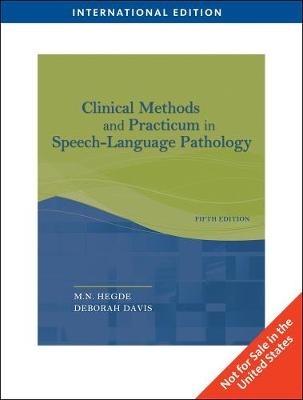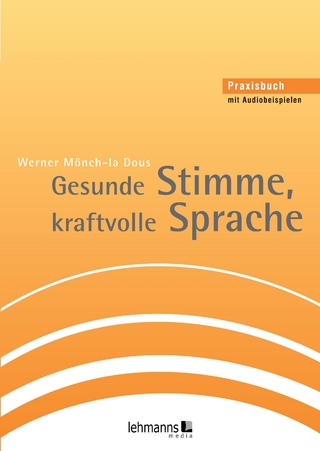
Clinical Methods and Practicum in Speech-Language Pathology, International Edition
Delmar Cengage Learning (Verlag)
978-1-4354-9986-7 (ISBN)
For student clinicians and clinical supervisors alike, clinical practicum in speech-language pathology is a learning experience that involves clearly defined expectations, ethical principles, and effective methods of treatment. This comprehensive resource provides a well-rounded discussion of the clinical practicum, including basic organization and competency guidelines, ethical and behavioral conduct between the student and supervisor and with clients, and multicultural issues encountered in clinical practice. Also presented are effective clinical methods in the treatment, control, and maintenance of communicative disorders.
M.N. (Giri) Hegde, PhD, is Professor of Communication Sciences and Disorders at California State University-Fresno. He holds a master¿s degree in experimental psychology from the University of Mysore, India, a post master¿s diploma in Medical (Clinical) Psychology form Bangalore University, India, and a doctoral degree in Speech-Language Pathology from Southern Illinois University at Carbondale. He is a specialist in fluency disorders, language disorders, research methods, and treatment procedures in communicative disorders. Widely published, Dr. Hegde has received many prestigious honors. Deborah Davis, MA, is Director of the Speech and Hearing Clinic at California State University-Fresno. She also supervises on- and off-campus clinical practicum. She holds a bachelors and masters degree from California State University-Fresno.
Part I: CLINICAL PRACTICUM.
1. Clinical Practicum in Speech-Language Pathology.
Clinical Practicum: An Overview. General Preclinic Requirements. ASHA Guidelines on Practicum. Clinical Practicum as a Learning Experience.
2. Organization of Clinical Practicum.
On-Campus Clinical Practicum. Off-Campus Practicum Sites. Clinical Internships. General Administrative Procedures. Clinical Supplies, Materials, and Equipment.
3. The Conduct of the Student Clinician.
General Professional Behavior. ASHA Code of Ethics. Other Codes and Regulations.
4. The Clinical Supervisor and the Student Clinician.
Role of the Clinical Supervisor. Off-Campus Clinical Supervision. Responsibilities of the Student Clinician.
5. Working with Clients.
Scheduling Clients. Assessment of Clients. Reassessment of Clients. Establishing a Working Relationship with Client and Family. Report Writing. Record-Keeping Procedures. Working with Other Professionals. Establishing Collaborative Relationships with Other Professionals.
6. Multicultural Issues in Clinical Practicum.
Student Clinicians with Multicultural Backgrounds. ASHA Position Statements. Assessment Issues. Treatment Issues. Working with an Interpreter.
Part II: CLINICAL METHODS IN SPEECH-LANGUAGE PATHOLOGY.
7. Target Behaviors across Disorders.
Selection of Target Behaviors. Approaches to Target Behavior Selection. Guidelines on Selecting Target Behaviors. Potential Target Behaviors Across Disorders.
8. Treatment in Speech-Language Pathology: Concepts and Methods.
Basic Methods of Treatment. How to Evoke Communicative Behaviors. Creating New Responses. Increasing the Frequency of Responses. Strengthening and Sustaining Target Behaviors. Sequence of Treatment.
9. Controlling Undesirable Behaviors.
Behaviors to Be Reduced. Assessment of the Maintaining Causes of Undesirable Behaviors. General Strategies for Decreasing Undesirable Behaviors. Direct Strategy for Decreasing Behaviors. Indirect Strategy for Decreasing Behaviors. General Guidelines for Reducing Undesirable Behaviors. Aversive Nature of Response-Reduction Procedures.
10. Maintenance of Target Behaviors.
Maintenance of Target Behaviors in Natural Settings. Maintenance Procedures. Developing Home Treatment Programs. Follow-up Assessments.
References.
Appendixes.
A. Glossary of Educational Abbreviations and Acronyms.
B. Glossary of Medical Abbreviations and Symbols.
C. Sample Recording Form.
D. Code of Ethics of the American Speech-Language-Hearing Association.
E. Sample Clinical Interview.
F. Examples of Dysfluency Types and Calculation of Dysfluency Rates.
G. Obtaining and Analyzing Conversational Speech Samples.
H. Sample Probe Recording Sheet.
I. Sample Treatment Plan.
J. Sample Lesson Plan.
K. Sample Diagnostic Report.
L. Discrete Trial Treatment Procedure and Recording Form.
M. Daily Progress Notes.
N. Sample Progress Report.
O. Sample Final Summary.
P. Sample Referral Letters.
Q. Discrete Trial Baseline Procedure and Recording Sheet.
Glossary.
Index.
| Erscheint lt. Verlag | 11.6.2009 |
|---|---|
| Verlagsort | Clifton Park |
| Sprache | englisch |
| Maße | 152 x 228 mm |
| Gewicht | 546 g |
| Themenwelt | Geisteswissenschaften ► Sprach- / Literaturwissenschaft ► Sprachwissenschaft |
| Medizin / Pharmazie ► Gesundheitsfachberufe ► Logopädie | |
| ISBN-10 | 1-4354-9986-7 / 1435499867 |
| ISBN-13 | 978-1-4354-9986-7 / 9781435499867 |
| Zustand | Neuware |
| Haben Sie eine Frage zum Produkt? |
aus dem Bereich


